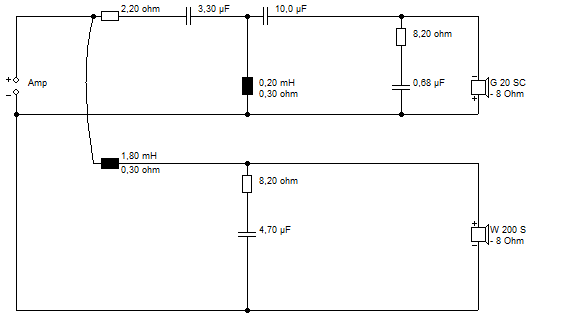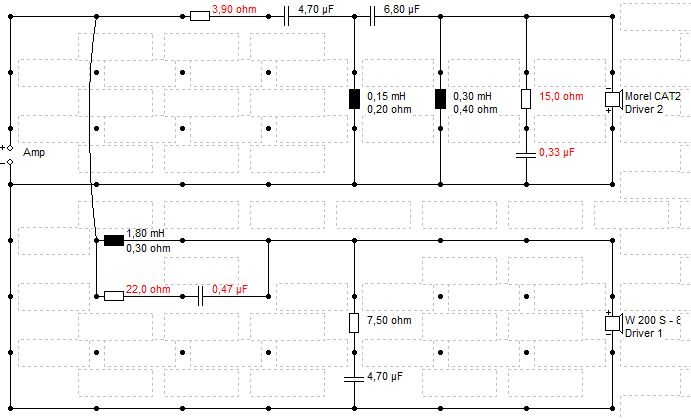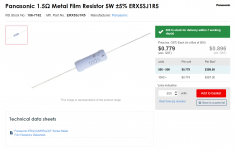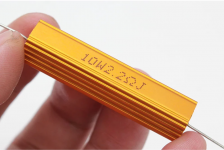Yes, of course listener satisfaction is 100% subjective, but what happens when he wants to do this again with another pair of speakers? Or, God forbid, build his own?
High i come back .
There is another point , this is a 12dB/octave filter . The possibility that it is wrong in phase is to retain . Try to invert the tweeter phase (only invert the connection wires) . It transform a 2dB notch to a 2dB boost in the transition region .
There is another point , this is a 12dB/octave filter . The possibility that it is wrong in phase is to retain . Try to invert the tweeter phase (only invert the connection wires) . It transform a 2dB notch to a 2dB boost in the transition region .
Yes, of course listener satisfaction is 100% subjective, but what happens when he wants to do this again with another pair of speakers? Or, God forbid, build his own?
Yes, without measuring frequency response this whole thing is an exercise is stupidity.
If you have two amplifiers, may I suggest you purchase a used active crossover, such as a dbx 234?
Connect amps horizontally or vertically biamped. After learning what your speaker driver crossover points are, you can set the crossover frequencies, experiment to determine best frequency.
Connect amps horizontally or vertically biamped. After learning what your speaker driver crossover points are, you can set the crossover frequencies, experiment to determine best frequency.
Well, again, THIS is about personal preference not absolute accuracy. I rarely ever need to make accurate measurements myself but agree; there is a time when there is no substitute for making in room measurements.
How is the DBX 234? I am tempted to one day go all active but some people say don't bother unless you get a high end unit (ie in excess of $1000+++ US). My drivers are very revealing and accurate; I have some high quality passive components on them and separate amps for each driver pair. I don't want to spend over $1000 just for a very small improvement.
Anyone out there with a fully active system that can advise me? What brands and model numbers do you recommend as high quality active crossovers???
Anyone out there with a fully active system that can advise me? What brands and model numbers do you recommend as high quality active crossovers???
but are they high quality? I guess I could try that route first and see if I think the sound quality is good enough. I just read a thing by Troels and he is like me; high quality passives can be just as good as electronic/active X/O's. That's why I mentioned the high end units.
The sound is high quality. For $100 or less, it was worth it for me. Expensive gear doesn't always equal high quality. Also, the sound pro's use this gear for a reason.
CROSSOVER RESISTORS: Wirewound versus Metal Film?
I am considering fitting METAL FILM resistors instead of the ubiquitous WIREWOUND variety - in the tweeter section of my crossover.
My logic stems from having used WIREWOUND resistors - very successfully - in my tube amp power supply, where the "lossy" nature of these resistors was very effective at lowering the noise floor in my amp. The high frequency extension greatly improved as a result.
(Not my idea. I got this tip from an old HAM Radio enthusiast...)
On this premise - and given that I am wanting to pass through as much high-frequency information as possible in my speaker's tweeter crossover section - I assumed it would be the last place that you'd want to put a "lossy" WIREWOUND resistor.
Has anyone else tried METAL FILM RESISTORS [correctly specified, of course...] in their crossover tweeter circuit?
I am considering fitting METAL FILM resistors instead of the ubiquitous WIREWOUND variety - in the tweeter section of my crossover.
My logic stems from having used WIREWOUND resistors - very successfully - in my tube amp power supply, where the "lossy" nature of these resistors was very effective at lowering the noise floor in my amp. The high frequency extension greatly improved as a result.
(Not my idea. I got this tip from an old HAM Radio enthusiast...)
On this premise - and given that I am wanting to pass through as much high-frequency information as possible in my speaker's tweeter crossover section - I assumed it would be the last place that you'd want to put a "lossy" WIREWOUND resistor.
Has anyone else tried METAL FILM RESISTORS [correctly specified, of course...] in their crossover tweeter circuit?
Last edited:
Blocked
I found these; 3 W max size in metal film. I have used many types of higher quality non-inductive wound resistors. I like the Zisters that Meniscus stocks in the US. I don't know if they are available world wide. Many people like the Bourns brand also. The Zisters, Bourns and others come in higher wattages. There may be other metal film rated above 3 W; even in a tweeter circuit, 3 Watts may not be enough although at 1.5 Ohms it might be OK.
I'm curious what others may find or might have tried.
I found these; 3 W max size in metal film. I have used many types of higher quality non-inductive wound resistors. I like the Zisters that Meniscus stocks in the US. I don't know if they are available world wide. Many people like the Bourns brand also. The Zisters, Bourns and others come in higher wattages. There may be other metal film rated above 3 W; even in a tweeter circuit, 3 Watts may not be enough although at 1.5 Ohms it might be OK.
I'm curious what others may find or might have tried.
I think you are wasting your time on film resistors TBH. Cheap ceramics are far more linear and non-inductive than the tweeter itself. All copper wire in the end. And so is the voicecoil. Anecdotally, changing NPE capacitors to film types makes more difference.
You'd make far more difference to sound with a higher order crossover, because second order can be a bit ropey on frequency response.


But without a full schematic and some modelling it is impossible to say how other imponderables like phase and impedance work out.
You'd make far more difference to sound with a higher order crossover, because second order can be a bit ropey on frequency response.
But without a full schematic and some modelling it is impossible to say how other imponderables like phase and impedance work out.
If you want more high-frequency, you might try a high frequency bypass capacitor across the attenuation resistor.... given that I am wanting to pass through as much high-frequency information as possible in my speaker's tweeter crossover section - I assumed it would be the last place that you'd want to put a "lossy" WIREWOUND resistor.
A value of 1/2 to 1/4 of the present capacitor would result in a gentle "lift" of the very high frequency, while leaving the high mid the same level as present.
Art
Attachments
Last edited:
I found that a bypass capacitor of the Sprague/CDE brand can help give some added brightness but still be polite (not overly harsh). Most definitely replace electrolytics (NPE) with at least a medium priced poly' cap of some kind; bypass helps.
Audyn (Intertechnik) Q4 series are a good, inexpensive capacitor. They come in a huge variety of values; WAY better than any stock NPE for sure.
Speakers Intertechnik - Shop - Shop
https://www.cde.com/resources/catalogs/716p.pdf
These are known as orange drops and are very inexpensive and I think widely available. There is also 715 series?; you want the 716P series which are poly' film + foil. Some say use 0.01 uF and 0.1 uF both as a bypass; could bypass caps and resistors both; they also have a decent small value range.
Audyn (Intertechnik) Q4 series are a good, inexpensive capacitor. They come in a huge variety of values; WAY better than any stock NPE for sure.
Speakers Intertechnik - Shop - Shop
https://www.cde.com/resources/catalogs/716p.pdf
These are known as orange drops and are very inexpensive and I think widely available. There is also 715 series?; you want the 716P series which are poly' film + foil. Some say use 0.01 uF and 0.1 uF both as a bypass; could bypass caps and resistors both; they also have a decent small value range.
If you want more high-frequency, you might try a high frequency bypass capacitor across the attenuation resistor.
A value of 1/2 to 1/4 of the present capacitor would result in a gentle "lift" of the very high frequency, while leaving the high mid the same level as present.
Art
Thanks Weltersys. This is a very interesting idea that I had not considered.
I was curious to see in your little diagram that you have inserted a [quality] +/- 1uF capacitor to bypass BOTH the Resistor and the current Capacitor in one leap, in this arrangement.
Was this intentional?
I assume this helps pass through any high frequencies that might have [possibly] been limited by the first cap...?
Last edited:
Blocked
I found these; 3 W max size in metal film. I have used many types of higher quality non-inductive wound resistors. I like the Zisters that Meniscus stocks in the US. I don't know if they are available world wide. Many people like the Bourns brand also. The Zisters, Bourns and others come in higher wattages. There may be other metal film rated above 3 W; even in a tweeter circuit, 3 Watts may not be enough although at 1.5 Ohms it might be OK.
I'm curious what others may find or might have tried.
These little guys tick all my boxes.
I also like the fact that the leads are copper; not ferrous metal.
I can buy a pack of 10 locally at the per unit rate, which is affordable.
This will give me a chance to precisely measure and match a pair for the use in both speakers.
[I'm always happy to have some stock leftover for future projects...]
Attachments
looks good to me! Panasonic passives are pretty good; I never used them in speakers but have in some electronics many times; good find!
LISTENING TEST 2 COMPLETED! [Tweeter Resistor 2.8-Ohm reduced to 1.2-Ohm]
This test was a BIG success - and our MAGNATs have never sounded so good or so balanced.
We used in the tweeter circuit, a 1.2-Ohm panel-mount resistor [see pic below...] that we had sitting around and it achieved all that I had hoped for.
The MAGNAT specs state that the top-end of this speaker is 35kHz. Without test gear, I won't make any claims, but this configuration REALLY allowed the MAGNAT tweeters to extend out. The purity and extension is just incredible.
Both my wife and I heard things in our favourite songs that we never heard before. Some of these favorites tracks have been with us for decades.
My wife's younger ears told her that the balance was "perfect, with no single area of fault."
For me, I felt that we now need just a shade less tweeter, so I am about to try a 1.5-ohm resistor.
In any event, I feel we are almost there - job done - and want to thank those of you who supported me on this journey. I have learned a lot.
Once I have the final configuration completed, I will report back for closure of this thread.
Hopefully any other newbies who are trying to achieve something similar with their speakers, will find some good info in this thread.
😀
This test was a BIG success - and our MAGNATs have never sounded so good or so balanced.
We used in the tweeter circuit, a 1.2-Ohm panel-mount resistor [see pic below...] that we had sitting around and it achieved all that I had hoped for.
The MAGNAT specs state that the top-end of this speaker is 35kHz. Without test gear, I won't make any claims, but this configuration REALLY allowed the MAGNAT tweeters to extend out. The purity and extension is just incredible.
Both my wife and I heard things in our favourite songs that we never heard before. Some of these favorites tracks have been with us for decades.
My wife's younger ears told her that the balance was "perfect, with no single area of fault."
For me, I felt that we now need just a shade less tweeter, so I am about to try a 1.5-ohm resistor.
In any event, I feel we are almost there - job done - and want to thank those of you who supported me on this journey. I have learned a lot.
Once I have the final configuration completed, I will report back for closure of this thread.
Hopefully any other newbies who are trying to achieve something similar with their speakers, will find some good info in this thread.
😀
Attachments
Last edited:
- Home
- Loudspeakers
- Multi-Way
- Quick win: My Tweeters are too quiet!


